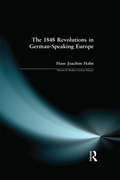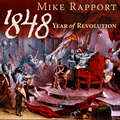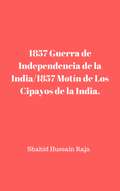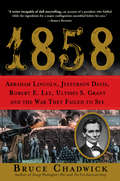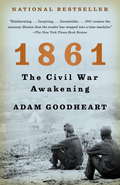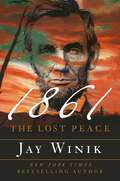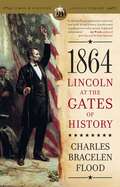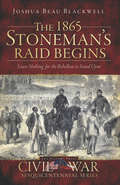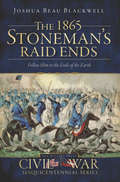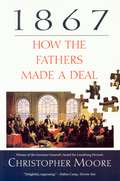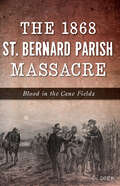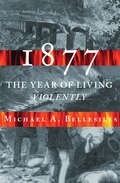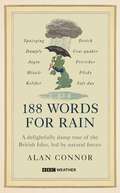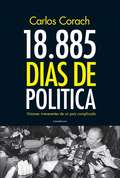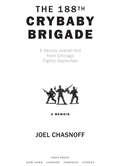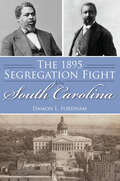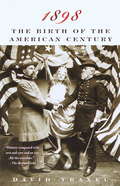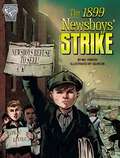- Table View
- List View
The 1848 Revolutions in German-Speaking Europe (Themes In Modern German History)
by H. J. HahnIn 1848 the continent of Europe was rocked by revolutions: only Great Britain and Russia remained relatively immune to the upheaval. Most spectacularly, the Revolutions swept across the German-speaking lands of central Europe, with the newly-released forces of nationalism and mass popular protest smashing the reactionary Metternich regimes which had held sway since the defeat of Napoleon. The Metternich system was dead: nationalism and national self-determination asserted themselves as the dominant dynamic forces of continental Europe in the later nineteenth century. This impressive history examines the political and social implications of the 1848 Revolutions for the future destiny and shape of Europe as a whole, and explores the wider forces at play in the German lands of nineteenth-century Europe.
1848: Year Of Revolution
by x Mike RapportIn 1848, Europe was engulfed in a firestorm of revolution. The streets of cities from Paris to Bucharest and from Berlin to Palermo were barricaded and flooded by armed insurgents proclaiming political liberties and national freedom. The conservative order which had held sway since the fall of Napoleon in 1815 crumbled beneath the revolutionary assault. This book narrates the breathtaking events which overtook Europe in 1848, tracing brilliantly their course from the exhilaration of the liberal triumph, through the fear of social chaos to the final despair of defeat and disillusionment. The failures of 1848 would scar European history with the contradictions of authoritarianism and revolution until deep into the twentieth century.
The 1849 Cholera Outbreak in Jefferson City (Disaster)
by Gary ElliottIn 1849, a steamship named after President James Monroe headed from St. Louis to Council Bluffs, Iowa. The passengers were members of the Church of Jesus Christ of Latter-day Saints from Philadelphia. At St. Louis, they were joined with a group of California gold diggers from Jeffersonville, Indiana. But their trip was interrupted when cholera broke out on board. Local fourteen-year-old James McHenry discovered the steamship after it landed at Jefferson City and observed the dead and dying victims along the riverbank. Author Gary Elliott details the history of the outbreak in the city and its far-reaching effects.
1857 Guerra de Independencia de la India/1857 Motín de Los Cipayos de la India.
by Shahid Hussain RajaEl 27 de abril de 1857, ochenta y cinco soldados de un regimiento Bengalí de la British East Indian Company, publicado en Meerut, desobedecieron las órdenes de su oficial británico superior, de usar los nuevos cartuchos para los nuevos rifles Enfield, presuntamente empacados en grasa de vaca y cerdo. Se les impuso un castigo severo a los soldados desobedientes, y esto también frente a sus colegas, resultando en el motín de varios regimientos y finalmente se convirtió en un levantamiento general de la gente de India. Fueron despiadadamente reprimidos por los británicos con la ayuda de su tecnología superior y soporte de las élites locales. Sin embargo, como cualquier evento cataclísmico, dio origen a diferentes tendencias sociales, políticas y económicas, las cuales todavía están dando forma al curso de acontecimientos en los estados postcoloniales de India, Pakistán, Bangladesh y otros países del subcontinente Indio. Este pequeño manual intenta descubrir la naturaleza, causas y consecuencias de este hito tan importante de la historia de las luchas de la gente de India por la Independencia. Esto explica el trasfondo de la Guerra de Independencia de India en 1857 o como algunos escritores le llaman, El Motín de los Cipayos de la India de 1857, enumera en detalle las causas sociales, económicas y políticas de este acontecimiento trascendental, narra el curso de los eventos, razones de su fracaso y termina con un análisis acerca del impacto a largo y corto plazo. Por último, argumenta que muchas de las tendencias de hoy en día en India, Pakistán y Bangladesh tienen sus raíces en políticas adoptadas por los administradores británicos en las secuelas de este levantamiento.
The 1857 Indian Uprising and the British Empire
by Jill C. BenderSituating the 1857 Indian uprising within an imperial context, Jill C. Bender traces its ramifications across the four different colonial sites of Ireland, New Zealand, Jamaica, and southern Africa. Bender argues that the 1857 uprising shaped colonial Britons' perceptions of their own empire, revealing the possibilities of an integrated empire that could provide the resources to generate and 'justify' British power. In response to the uprising, Britons throughout the Empire debated colonial responsibility, methods of counter-insurrection, military recruiting practices, and colonial governance. Even after the rebellion had been suppressed, the violence of 1857 continued to have a lasting effect. The fears generated by the uprising transformed how the British understood their relationship with the 'colonized' and shaped their own expectations of themselves as 'colonizer'. Placing the 1857 Indian uprising within an imperial context reminds us that British power was neither natural nor inevitable, but had to be constructed.
The 1857 Indian Uprising and the Politics of Commemoration
by Sebastian Raj PenderThe Cawnpore Well, Lucknow Residency, and Delhi Ridge were sacred places within the British imagination of India. Sanctified by the colonial administration in commemoration of victory over the 'Sepoy Mutiny' of 1857, they were read as emblems of empire which embodied the central tenets of sacrifice, fortitude, and military prowess that underpinned Britain's imperial project. Since independence, however, these sites have been rededicated in honour of the 'First War of Independence' and are thus sacred to the memory of those who revolted against colonial rule, rather than those who saved it. The 1857 Indian Uprising and the Politics of Commemoration tells the story of these and other commemorative landscapes and uses them as prisms through which to view over 150 years of Indian history. Based on extensive archival research from India and Britain, Sebastian Raj Pender traces the ways in which commemoration responded to the demands of successive historical moments by shaping the events of 1857 from the perspective of the present. By telling the history of India through the transformation of mnemonic space, this study shows that remembering the past is always a political act.
1857 Indischer Unabhängigkeitskrieg (Meuterei der indischen Sepoys): Ursachen und Folgen
by Shahid Hussain RajaErläutert die Hintergründe des indischen Unabhängigkeitskrieges von 1857 oder das, was ein Teil der Schriftsteller als "Sepoy's Mutiny" von 1857 bezeichnet, zählt detailliert die sozialen, wirtschaftlichen und politischen Ursachen dieses folgenschweren Ereignisses auf, schildert den Verlauf der Ereignisse, die Gründe für das Scheitern und endet mit einer detaillierten Analyse der lang- und kurzfristigen Auswirkungen.
1857 ka Swatantry Samar: 1857 का स्वातंत्र्य समर
by Vinayak Damodar Savarkarवीर सावरकर रचित ‘१८५७ का स्वातंत्र्य समर’ विश्व की पहली इतिहास पुस्तक है, जिसे प्रकाशन के पूर्व ही प्रतिबंधित होने का गौरव प्राप्त हुआ। इस पुस्तक को ही यह गौरव प्राप्त है कि सन् १९०९ में इसके प्रथम गुप्त संस्करण के प्रकाशन से १९४७ में इसके प्रथम खुले प्रकाशन तक के अड़तीस वर्ष लंबे कालखंड में इसके कितने ही गुप्त संस्करण अनेक भाषाओं में छपकर देश-विदेश में वितरित होते रहे। इस पुस्तक को छिपाकर भारत में लाना एक साहसपूर्ण क्रांति-कर्म बन गया। यह देशभक्त क्रांतिकारियों की ‘गीता’ बन गई। इसकी अलभ्य प्रति को कहीं से खोज पाना सौभाग्य माना जाता था। इसकी एक-एक प्रति गुप्त रूप से एक हाथ से दूसरे हाथ होती हुई अनेक अंतःकरणों में क्रांति की ज्वाला सुलगा जाती थी। पुस्तक के लेखन से पूर्व सावरकर के मन में अनेक प्रश्न थे—सन् १८५७ का यथार्थ क्या है?क्या वह मात्र एक आकस्मिक सिपाही विद्रोह था? क्या उसके नेता अपने तुच्छ स्वार्थों की रक्षा के लिए अलग-अलग इस विद्रोह में कूद पड़े थे, या वे किसी बड़े लक्ष्य की प्राप्ति के लिए एक सुनियोजित प्रयास था? यदि हाँ, तो उस योजना में किस-किसका मस्तिष्क कार्य कर रहा था?योजना का स्वरूप क्या था?क्या सन् १८५७ एक बीता हुआ बंद अध्याय है या भविष्य के लिए प्रेरणादायी जीवंत यात्रा?भारत की भावी पीढि़यों के लिए १८५७ का संदेश क्या है? आदि-आदि। और उन्हीं ज्वलंत प्रश्नों की परिणति है प्रस्तुत ग्रंथ—‘१८५७ का स्वातंत्र्य समर’! इसमें तत्कालीन संपूर्ण भारत की सामाजिक व राजनीतिक स्थिति के वर्णन के साथ ही हाहाकार मचा देनेवाले रण-तांडव का भी सिलसिलेवार, हृदय-द्रावक व सप्रमाण वर्णन है। प्रत्येक देशभक्त भारतीय हेतु पठनीय व संग्रहणीय, अलभ्य कृति!
1858: Abraham Lincoln, Jefferson Davis, Robert E. Lee, Ulysses S. Grant and the War They Failed to See
by Bruce Chadwick1858 explores the events and personalities of the year that would send the America's North and South on a collision course culminating in the slaughter of 630,000 of the nation's young men, a greater number than died in any other American conflict. The record of that year is told in seven separate stories, each participant, though unaware, is linked to the oncoming tragedy by the central, though ineffective, figure of that time, the man in the White House, President James Buchanan. The seven figures who suddenly leap onto history's stage and shape the great moments to come are: Jefferson Davis, who lived a life out of a Romantic novel, and who almost died from herpes simplex of the eye; the disgruntled Col. Robert E. Lee, who had to decide whether he would stay in the military or return to Virginia to run his family's plantation; William Tecumseh Sherman, one of the great Union generals, who had been reduced to running a roadside food stand in Kansas; the uprising of eight abolitionists in Oberlin, Ohio, who freed a slave apprehended by slave catchers, and set off a fiery debate across America; a dramatic speech by New York Senator William Seward in Rochester, which foreshadowed the civil war and which seemed to solidify his hold on the 1860 Republican Presidential nomination; John Brown's raid on a plantation in Missouri, where he freed several slaves, and marched them eleven hundred miles to Canada, to be followed a year later by his catastrophic attack on Harper's Ferry; and finally, Illinois Senator Steven Douglas' seven historic debates with little-known Abraham Lincoln in the Illinois Senate race, that would help bring the ambitious and determined Lincoln to the Presidency of the United States. As these stories unfold, the reader learns how the country reluctantly stumbled towards that moment in April 1861 when the Southern army opened fire on Fort Sumter.
1861
by Adam GoodheartAs the United States marks the 150th anniversary of our defining national drama, 1861 presents a gripping and original account of how the Civil War began.1861 is an epic of courage and heroism beyond the battlefields. Early in that fateful year, a second American revolution unfolded, inspiring a new generation to reject their parents' faith in compromise and appeasement, to do the unthinkable in the name of an ideal. It set Abraham Lincoln on the path to greatness and millions of slaves on the road to freedom.The book introduces us to a heretofore little-known cast of Civil War heroes--among them an acrobatic militia colonel, an explorer's wife, an idealistic band of German immigrants, a regiment of New York City firemen, a community of Virginia slaves, and a young college professor who would one day become president. Adam Goodheart takes us from the corridors of the White House to the slums of Manhattan, from the mouth of the Chesapeake to the deserts of Nevada, from Boston Common to Alcatraz Island, vividly evoking the Union at this moment of ultimate crisis and decision.From the Hardcover edition.
1861: The Lost Peace
by Jay WinikFrom an award-winning historian and New York Times bestselling author, a gripping, fly-on-the-wall account of the weeks leading up to Abraham Lincoln's decision to go to war against the Confederacy.1861: The Lost Peace is the story of President Lincoln&’s difficult and courageous decision at a time when the country wrestled with deep moral questions of epic proportions. Through Jay Winik&’s singular reporting and storytelling, readers will learn about the extraordinary Washington Peace Conference at the Willard Hotel to avert cataclysmic war. They will observe the irascible and farsighted Senator JJ Crittenden, the tireless moderate seeking a middle way to peace. Lincoln himself called Crittenden &“a great man&” even as Lincoln jousted with him. Readers will glimpse inside Lincoln&’s cabinet—the finest in history—which rivaled the executive in its authority, a fact too often forgotten, and witness a parade of statesmen frenetically grasping for peace rather than the spectacle of a young nation slowly choking itself to death. A perfect read for history buffs, with timely overtones to our current political climate.
1864
by Charles Bracelen FloodIn a masterful narrative, historian and biographer Charles Bracelen Flood brings to life the drama of Lincoln's final year, in which he oversaw the last campaigns of the Civil War, was reelected as president, and laid out his majestic vision for the nation's future in a reunified South and in the expanding West.
The 1865 Stoneman's Raid Begins: Leave Nothing for the Rebellion to Stand Upon (Civil War Series)
by Joshua Beau BlackwellStriking out from Knoxville, Tennessee in late March of 1865, Major General George Stoneman unleashed his cavalry division upon Southern Appalachia intent on "leaving nothing for the Rebellion to stand upon." The raiders wreaked havoc on government stores, civilian property and indispensable infrastructure, dashing all hope for the dying Confederacy's stand on the rugged peaks of the Blue Ridge. They eventually trampled through five southern states, reduced to ashes one of the last major prisons in the south and helped pursue the renegade president. But much more than wanton destruction, their story is one of hardship, redemption and retribution. Taking into account the local folklore of the Raid, this volume traces the column's course as it departed Tennessee, penetrated Southwestern Virginia and stormed the North Carolina Piedmont.
1865 Stoneman's Raid Ends, The: Follow Him to the Ends of the Earth (Civil War Ser.)
by Joshua Beau BlackwellIn the spring of 1865, George Stoneman's cavalry division departed Salisbury, North Carolina, with one objective in mind: returning home. However, after the collapse of the Confederacy, the mounted division was ordered to apprehend the exiled Confederate president Jefferson Davis, even if it meant "follow[ing] him to the ends of the earth."? By May, the raid had transformed into an uphill struggle of frustration, pillage, revenge, terror and wavering loyalty to the flag as the troopers crashed down on the civilian populations that lay in their path with demonical ferocity. Taking into account local folklore and traditions of the raid, historian Beau Blackwell follows the column's course as it sacks the city of Asheville, canvasses the Palmetto State, plunders Greenville, terrorizes Anderson and ultimately tramples the soil of Georgia.
1867: How the Fathers Made a Deal
by Christopher Moore“In the 1860s, western alienation began at Yonge Street, and George Brown was the Preston Manning of the day. ” So begins Christopher Moore’s fascinating 1990s look at the messy, dramatic, crisis-ridden process that brought Canada into being – and at the politicians, no more lovable or united than our own, who, against all odds, managed to forge a deal that worked. From the first chapter, he turns a fresh, perceptive, and lucid eye on the people, the issues, and the political theories of Confederation – from John A. Macdonald’s canny handling of leadership to the invention of federalism and the Senate, from the Quebec question to the influence of political philosophers Edmund Burke and Walter Bagehot. This is a book for all Canadians who love their country – and fear for it after the failure of the constitution-making of the 1990s. Here is a clear, entertaining reintroduction to the ideas and processes that forged the nation. From the Hardcover edition.
The 1868 St. Bernard Parish Massacre: Blood in the Cane Fields (True Crime Ser.)
by C. DierThe slaughter of newly liberated African Americans just days before a Reconstruction Era election is recounted in this true crime history.Louisiana, 1868. With the Civil War over, a victorious Ulysses S. Grant was riding a wave of popularity straight to the White House. But former Confederates across the South feared what Reconstruction might look like under President Grant. Days before the tumultuous election, Louisiana&’s St. Bernard Parish descended into chaos. As African American men gained the right to vote, white Democrats of the parish feared losing their majority. Armed groups mobilized to suppress these recently emancipated voters. Freed people were dragged from their homes and murdered in cold blood. Many fled to the cane fields to hide from their attackers. The reported number of those killed varies from 35 to 135. Though efforts were made to cover up the tragedy, its implications reverberated throughout the South and lingered for generations. In this authoritative chronicle, historian Chris Dier reveals the horrifying true story behind the St. Bernard Parish Massacre.
1877: America's Year of Living Violently
by Michael A. Bellesiles&“[A] powerful examination of a nation trying to make sense of the complex changes and challenges of the post–Civil War era.&” —Carol Berkin, author of A Brilliant Solution: Inventing the American Constitution In 1877—a decade after the Civil War—not only was the United States gripped by a deep depression, but the country was also in the throes of nearly unimaginable violence and upheaval, marking the end of the brief period known as Reconstruction and reestablishing white rule across the South. In the wake of the contested presidential election of 1876, white supremacist mobs swept across the South, killing and driving out the last of the Reconstruction state governments. A strike involving millions of railroad workers turned violent as it spread from coast to coast, and for a moment seemed close to toppling the nation&’s economic structure. Celebrated historian Michael A. Bellesiles reveals that the fires of that fated year also fueled a hothouse of cultural and intellectual innovation. He relates the story of 1877 not just through dramatic events, but also through the lives of famous and little-known Americans alike. &“A superb and troubling book about the soul of Modern America.&” —William Deverell, director of the Huntington-USC Institute on California and the West &“A bold, insightful book, richly researched, and fast paced . . . Bellesiles vividly portrays on a single canvas the violent confrontations in 1877.&” —Alfred F. Young, coeditor of Revolutionary Founders: Rebels, Radicals, and Reformers in the Making of the Nation &“[A] wonderful read that is sure to appeal to those interested in the challenges of creating a post–Civil War society.&” —Choice
188 Words for Rain: A delightfully damp tour of the British Isles, led by natural forces (an official BBC Weather book)
by Alan Connor‘Alan knows everything, knows everyone, and writes beautifully too.’RICHARD OSMAN‘The man with the contents of the Oxford English Dictionary stored just above his left eyebrow … and he’s quite funny too.’RORY CELLAN-JONES'A gorgeous, funny tour of the British Isles as seen from the clouds.’KONNIE HUQFor fans of THE ETYMOLOGICON and VERY BRITISH PROBLEMS, a delightfully damp tour of the British Isles. Mizzle. Dreich. Raining knives and forks. A real mugga-fisty. A spot of plother...We Brits love talking about the weather. So much so that our islands have hundreds of words and phrases for rain, some self-explanatory and others that really leave us scratching our heads. From a light smirr in Aberdeen to a "it's raining knives and forks!" in the Brecon Beacons, each type of rain tells a story about the people and places it falls on.In this delightfully damp tour of the British Isles, writer and puddle-splasher Alan Connor digs deep into the meaning and quirky histories of over one hundred words for precipitation. He gets caught in a plash in Northumberland, crashes a fox's wedding in Devon and ponders the phenomenon of Brits-who-picnic-in-the-car, in this charming and witty celebration of our very British obsession.
1888: London Murders in the Year of the Ripper
by Peter StubleyIn 1888 Jack the Ripper made the headlines with a series of horrific murders that remain unsolved to this day. But most killers are not shadowy figures stalking the streets with a lust for blood. Many are ordinary citizens driven to the ultimate crime by circumstance, a fit of anger or a desire for revenge. Their crimes, overshadowed by the few, sensational cases, are ignored, forgotten or written off. This book examines all the known murders in London in 1888 to build a picture of society. Who were the victims? How did they live, and how did they die? Why did a husband batter his wife to death after she failed to get him a cup of tea? How many died under the wheels of a horse-driven cab? Just how dangerous was London in 1888?
"1888" For Almost Dummies
by Robert J. Wieland"1888" marks the "beginning" of the world's second Pentecost, and people everywhere are at last beginning to ferret out the story. There is a skeleton in our closet.
18885 DÍAS DE POLITICA (EBOOK)
by Carlos CorachCarlos Corach confiesa aquí que ha vivido (y sigue viviendo) una intensa vida política: del desarrollismo al menemismo, del Colegio Nacional de Buenos Aires al Pacto de Olivos, el ex ministro del Interior repasa cada peldaño, cada alegría, cada traspié y cada enseñanza de su carrera. No evita tema alguno y subraya en todos una necesidad que hoy parece olvidada: la del diálogo como herramienta principal de la política. Dice Corach, en estas memorias de 18.885 días que se leen en uno, como un apasionante manual de historia argentina reciente: "Entendí que la política exige comprender y aceptar la diversidad de opiniones, que siempre hay que dialogar con aquellos con quienes disentimos y que la relación con los adversarios, permanentes o circunstanciales, exige siempre el respeto mutuo".
The 188th Crybaby Brigade: A Memoir
by Joel ChasnoffLook at me. Do you see me? Do you see me in my olive-green uniform, beret, and shiny black boots? Do you see the assault rifle slung across my chest? Finally! I am the badass Israeli soldier at the side of the road, in sunglasses, forearms like bricks. And honestly -- have you ever seen anything quite like me?Joel Chasnoff is twenty-four years old, an American, and the graduate of an Ivy League university. But when his career as a stand-up comic fails to get off the ground, Chasnoff decides it's time for a serious change of pace. Leaving behind his amenity-laden Brooklyn apartment for a plane ticket to Israel, Joel trades in the comforts of being a stereotypical American Jewish male for an Uzi, dog tags (with his name misspelled), and serious mental and physical abuse at the hands of the Israeli Army. The 188th Crybaby Brigade is a hilarious and poignant account of Chasnoff's year in the Israel Defense Forces -- a year that he volunteered for, and that he'll never get back. As a member of the 188th Armored Brigade, a unit trained on the Merkava tanks that make up the backbone of Israeli ground forces, Chasnoff finds himself caught in a twilight zone-like world of mandatory snack breaks, battalion sing-alongs, and eighteen-year-old Israeli mama's boys who feign injuries to get out of guard duty and claim diarrhea to avoid kitchen work. More time is spent arguing over how to roll a sleeve cuff than studying the mechanics of the Merkava tanks. The platoon sergeants are barely older than the soldiers and are younger than Chasnoff himself. By the time he's sent to Lebanon for a tour of duty against Hezbollah, Chasnoff knows everything about why snot dries out in the desert, yet has never been trained in firing the MAG. And all this while his relationship with his tough-as-nails Israeli girlfriend (herself a former drill sergeant) crumbles before his very eyes. The lone American in a platoon of eighteen-year-old Israelis, Chasnoff takes readers into the barracks; over, under, and through political fences; and face-to-face with the absurd reality of life in the Israeli Army. It is a brash and gritty depiction of combat, rife with ego clashes, breakdowns in morale, training mishaps that almost cost lives, and the barely containable sexual urges of a group of teenagers. What's more, it's an on-the-ground account of life in one of the most embattled armies on earth -- an occupying force in a hostile land, surrounded by enemy governments and terrorists, reviled by much of the world. With equal parts irreverence and vulnerability, irony and intimacy, Chasnoff narrates a new kind of coming-of-age story -- one that teaches us, moves us, and makes us laugh.
The 1895 Segregation Fight in South Carolina (American Heritage)
by Damon L. FordhamSix Against the StateIn 1895, Senator Benjamin Tillman of South Carolina attempted to solidify his political power. He proposed to rewrite the South Carolina Constitution to deny African Americans their constitutional rights and make racial segregation the law of the state. Six Black leaders--Robert Anderson, Isaiah Reed, Robert Smalls, William J. Whipper, James Wigg and Thomas E. Miller--went to the state capitol in the face of insult and ridicule to make an eloquent stand against these developments. The erudite and forceful addresses of these men drew worldwide headlines but are largely forgotten today. Author Damon L. Fordham attempts to rectify that omission and inspire generations to come.
1898: The Birth of the American Century
by David TraxelHistorian Traxel narrates the extraordinary events of 1898 to unfold the story of America's metamorphosis from a rural, isolationist society into a commanding presence on the world stage. The account centers upon America's first foray into international military affairs, the Spanish-American War, but also covers worker uprisings, racial conflict, the last battle between Native Americans and the US Army, advances in technology, and the growing importance of advertising. Annotation c. by Book News, Inc. , Portland, Or.
The 1899 Newsboys' Strike (Movements And Resistance Ser.)
by Nel YomtovIn the late 1800s, newsboys—or “newsies”—were a critical part of the newspaper industry. They bought stacks of papers from newspaper publishers and then sold them on city streets for a small profit. But in 1898, William Randolph Hearst’s New York Journal and Joseph Pulitzer’s New York World raised the cost of 100 papers by 10 cents. The price increase cut into the newsboys’ profits, and by the summer of 1899 their frustration boiled over. They banded together and showed the world how activists of any age can use a strike to win against even the most rich and powerful.
